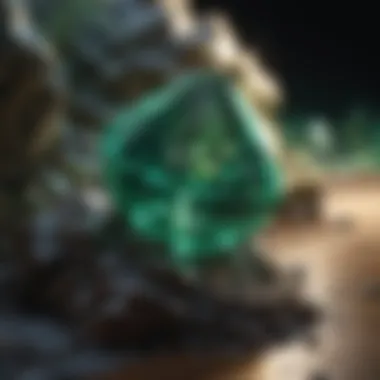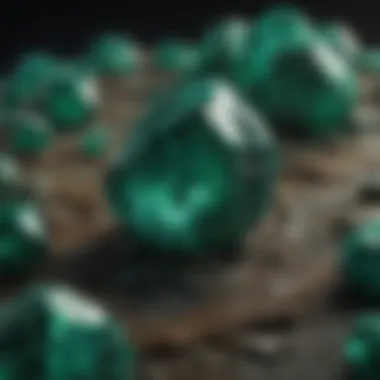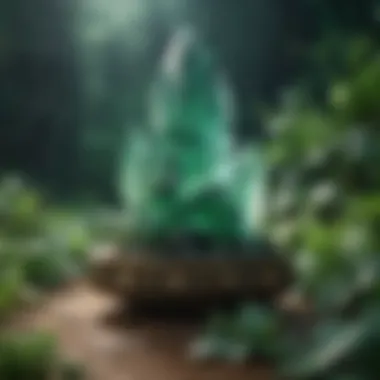Unveiling the Enchanting World of Diverse Green Crystals


Rock and Fossil Identification
When delving into the vibrant world of different green crystals, it is crucial to understand their origin and formation. Green crystals, such as emeralds and malachite, are prized for their unique geological properties. Emeralds, for instance, are a variety of the mineral beryl and acquire their green color from trace amounts of chromium or vanadium. On the other hand, malachite, with its striking green bands, forms as a secondary mineral in the oxidized zone of copper ore deposits. To identify these green crystals, one must pay attention to specific characteristics – emeralds, for instance, exhibit a rich green color, often with inclusions, while malachite displays distinct banded patterns. Utilizing tools like a jeweler's loupe can aid in examining the clarity and internal features of these crystals, providing valuable insights for collectors.
Collecting Tips and Techniques
For avid collectors seeking to expand their green crystal collection, it is essential to employ best practices when hunting for these geological treasures. Locating prime collecting sites can involve researching geological maps to pinpoint regions known for producing green crystals. Emeralds, for example, are commonly found in countries like Colombia, Zambia, and Brazil, whereas malachite can be located in various copper-rich areas worldwide. When extracting specimens, collectors must adhere to safety protocols to avoid damage to both the crystals and surrounding environment. Tools such as chisels, brushes, and protective gear are indispensable for safely uncovering and retrieving green crystals.
Preservation and Display
Preserving the pristine beauty of green crystals is paramount for collectors looking to maintain the quality of their specimens. Techniques such as using archival-quality packaging and storing crystals in a stable environment can prevent degradation over time. Proper storage methods involve keeping crystals away from direct sunlight or excessive moisture, which can affect their color and composition. Creative display ideas, such as arranging crystals in shadow boxes or illuminated shelves, can enhance their aesthetic appeal and allow collectors to showcase their prized possessions with elegance and sophistication.
Geological Insights
Behind the captivating allure of green crystals lie intricate geological processes that have shaped these natural wonders throughout history. Understanding the geological formations that give rise to emeralds and malachite unveils the fascinating connection between geology and gemology. The historical significance of these crystals, from ancient civilizations to modern lapidary practices, underscores their enduring appeal and cultural relevance. Notable discoveries in the field continue to expand our knowledge of green crystals, shedding light on their rarity and geological importance in the ever-evolving world of rock and fossil collecting.
Introduction


In the intriguing world of gemstones and crystals, the allure of green specimens has captivated enthusiasts and collectors for centuries. This article serves as a comprehensive guide to exploring the enchanting realm of different green crystals, shedding light on their origins, properties, and significance in the realm of geological wonders.
Green crystals such as emeralds, malachite, and jade hold a special place in the hearts of collectors due to their unique coloration, distinct features, and historical importance. These precious stones have a rich cultural and geological heritage that sets them apart from other gemstones, making them highly sought-after by connoisseurs worldwide.
As we embark on this insightful journey, we will delve into the origins and formation processes of emeralds, unravel the chemical composition that gives malachite its vibrant hues, and explore the cultural importance and symbolism associated with jade. Each green crystal brings its own set of distinctive properties and characteristics that make them not only aesthetically pleasing but also intellectually stimulating to study and appreciate.
Throughout this article, we will unravel the mysteries surrounding these green treasures, offering a deep dive into their geological occurrences, rare attributes, and metaphysical beliefs. By the end of our exploration, readers will gain a newfound appreciation for the beauty and complexity of different green crystals, elevating their understanding of these natural wonders to new heights.
Understanding Green Crystals
Emerald
Origins and Formation
Emeralds, known for their stunning green color, are gemstones that hold a rich history and geological significance. The origins and formation of emeralds trace back to intense pressure and heat within the Earth's crust, where beryl compositions create these mesmerizing gems. This formation process contributes to the rarity and value of emeralds, making them highly sought after by collectors and jewelers alike. The unique feature of emerald formation lies in the delicate balance of elements required, resulting in their alluring green hues. Despite their exquisite beauty, emeralds can be fragile due to natural inclusions, which both enhance their beauty and pose challenges in cutting and setting these gemstones.
Chemical Composition
The chemical composition of emeralds plays a crucial role in their defining characteristics. Comprised of beryllium, aluminum, silicon, and oxygen, emeralds derive their distinctive green color from traces of chromium, vanadium, or iron present during their formation. This composition not only determines the color intensity of emeralds but also influences their durability and clarity. The notable feature of emerald chemistry is how these trace elements interact to create different shades of green, from deep emerald greens to lighter hues. Understanding the chemical composition of emeralds is essential for gemologists and collectors to assess their quality and authenticity accurately.


Notable Properties
Emeralds exhibit remarkable properties that set them apart as prized gemstones. Known for their brilliance and fire, emeralds possess a unique
Rare Green Crystals
In this section, we delve into the captivating realm of Rare Green Crystals, illuminating their significance within the broader context of this article. Rare Green Crystals offer a unique and intriguing insight into the world of crystal collecting, drawing in enthusiasts with their scarcity and exceptional properties. Understanding Rare Green Crystals provides collectors with a deeper appreciation for the diversity of the crystal kingdom and the geological processes that shape these extraordinary gems.
Gaspeite
Uncommon Characteristics
Gaspeite exhibits a set of distinctive Uncommon Characteristics that set it apart within the realm of green crystals. Its vibrant green hue, often interspersed with striking patterns, makes Gaspeite a coveted choice among collectors seeking something truly unique. The rarity of Gaspeite adds to its allure, attracting those who appreciate the scarcity and exclusivity of such specimens. Its Uncommon Characteristics, including its rarity and exceptional coloration, position Gaspeite as a prized addition to any crystal collection, making it a standout feature in this article.
Collectibility
The Collectibility of Gaspeite lies in its scarcity and the fervor it ignites among collectors. Due to its limited supply and high demand from enthusiasts, Gaspeite holds a special place in the world of rare crystals. Collectors seek out Gaspeite not only for its aesthetic appeal but also for its investment value, making it a sought-after gem in the market. Its Collectibility underscores the unique allure that Gaspeite brings to this article, highlighting its significance in the realm of precious crystals.


Geological Occurrence
Gaspeite's Geological Occurrence adds an intriguing layer to its overall appeal. Found in select geological formations, Gaspeite emerges as a gem with a rich backstory tied to its specific mining locations and geological conditions. Understanding the Geological Occurrence of Gaspeite provides collectors with a deeper appreciation for the natural forces that have shaped this exceptional crystal. Its fascinating origin story and limited distribution make Gaspeite a valuable inclusion in this article, shedding light on its geological significance and rarity.
Metaphysical Beliefs and Healing Properties
Green Aventurine stands out in the realm of different green crystals, revered for its metaphysical beliefs and healing properties. In this detailed exploration, we delve into the significance of metaphysical beliefs and healing properties within the context of green crystals. Unraveling the mysteries and ancient practices associated with these ethereal properties, we uncover how they intertwine with our spiritual and physical well-being.
Spiritual Significance
The spiritual significance of Green Aventurine is profound, bringing a sense of renewal and growth to those who seek its energies. Its inherent connection to the heart chakra fosters compassion, harmony, and emotional balance. Green Aventurine serves as a beacon of hope, igniting a sense of optimism and prosperity in the hearts of individuals. Its ability to attract abundance and ward off negativity makes it a popular choice among users seeking spiritual upliftment.
Healing Powers
The healing powers of Green Aventurine extend beyond the physical realm, delving into emotional and spiritual healing. Known as the
Conclusion
In the intricate world of different green crystals, the conclusion serves as a significant culmination of the knowledge and insights shared throughout this enlightening article. As we navigate through the sparkling allure of emeralds to the rich vibrancy of malachite and the cultural significance of jade, it becomes apparent that these green-hued crystals hold not just aesthetic value but also geological and metaphysical importance.
The importance of the conclusion lies in summarizing the key takeaways for rock and fossil collectors, highlighting the variations in origins, formations, and properties of green crystals discussed. It offers a cohesive wrap-up, encapsulating the essence of each crystal's uniqueness and the enigmatic allure they hold for collectors. By emphasizing the relevance of understanding the geological occurrences of crystals like gaspeite, hiddenite, and variscite, the conclusion provides a comprehensive overview for enthusiasts.
Furthermore, the conclusion delves into the metaphysical beliefs and healing properties associated with green crystals, shedding light on how crystals like green aventurine, peridot, and prehnite are believed to align chakras, promote holistic well-being, and foster emotional balance. This holistic view of green crystals not only appeals to collectors but also invokes a deeper sense of connection to nature and spirituality.
Moreover, the conclusion serves as a guide for readers to explore the diverse world of green crystals, inviting them to delve deeper into their unique qualities and significance. By synthesizing the information presented throughout the article, the conclusion underscores the timeless beauty and enduring fascination that green crystals hold for collectors, making it an indispensable resource for those passionate about the mystique of earth's treasures.







